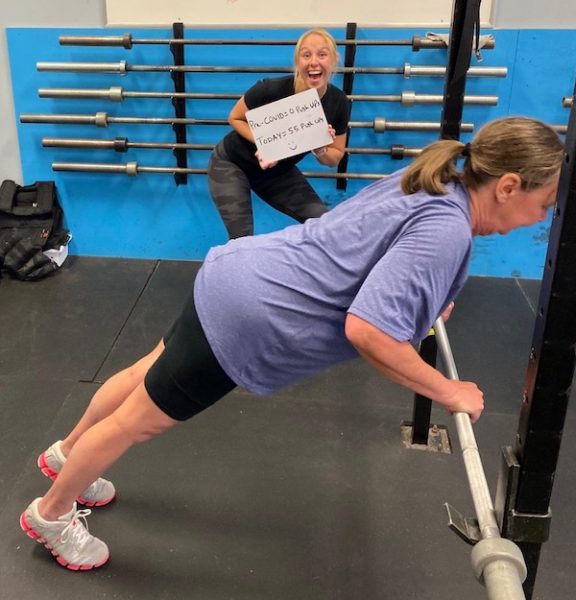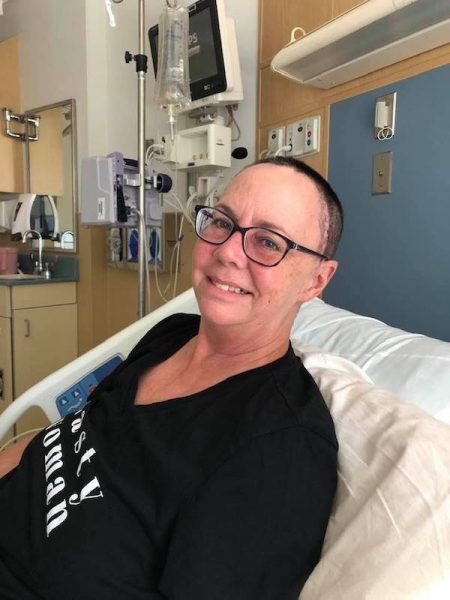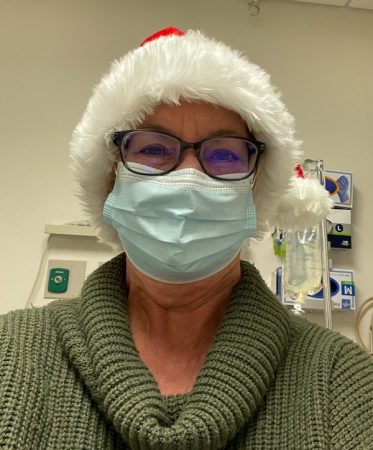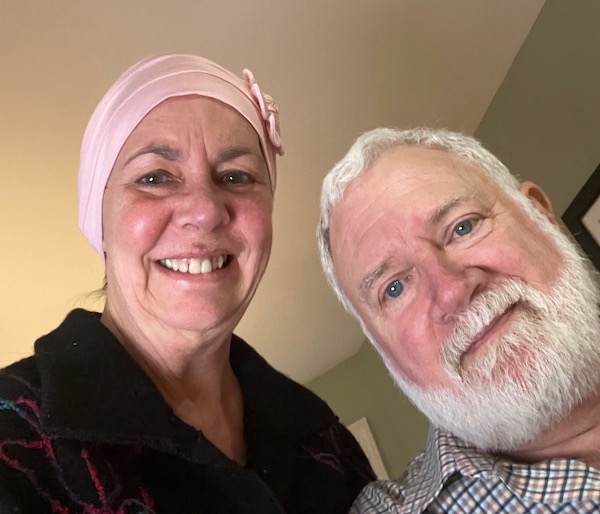
Kim Laramy set an ambitious goal for herself at the beginning of 2021 — to do some form of workout/exercise every single day. Come September she was feeling really good about what she had accomplished so far. In other words, Kim was kicking butt.
On Thursday, September 22nd, she had just finished doing her usual warm-up session with her personal trainer and was preparing to deadlift 75 pounds.
Not an unusual weight, but as soon as I picked it up something felt weird. I remember saying to Jess Cote, my trainer, “Something is wrong” and then I passed out. The notes from the EMTs said I convulsed and more yucky stuff.
Kim Laramy
Kim’s partner Wayne Clark raced to the hospital when he got the call, arriving at the same time as the ambulance.
Long story short, Kim had a subarachnoid hemorrhage. They stabilized her and did an initial CT at Mercy, then transferred her to the neurosurgery service at Maine Med. It was a long, long night.
Wayne Clark, Kim’s partner
A subarachnoid hemorrhage means that a blood vessel in the brain has ruptured or been damaged and there is bleeding into the space between the membrane that covers the brain and the brain itself. When that happens it’s a life or death situation.
In Kim’s case, an aneurysm or weak spot in a blood vessel had ruptured. She had a 50-50 chance of surviving. For those who do make it, about 66 percent will suffer some permanent brain damage. Nearly 15 percent of people with a ruptured aneurysm die before they even get to the hospital. Kim passed the first test. On to the next.
The following morning she spent five hours in the operating room while neurosurgeon Dr. Robert Ecker repaired the blood vessel that had ruptured.
Wayne, who has spent his entire adult life as a health care communicator and has seen just about everything, was in awe at what Dr. Ecker was able to accomplish. “Think about it,” he wrote in an online journal he was keeping.
They insert a catheter in the groin and pass it up through to the brain. There are obstacles along the way, like the kidney. Once there, they “light up” the cranial vessels with contrast agent and see where one or more is leaking. Then — using the same catheter — they clamp off the leak. If that’s not magic, I’m not sure what is.
Wayne
Dr. Ecker’s notes after surgery said that Kim was “awake, alert, motor intact. Working towards extubation.”
Extubation means breathing without a ventilator. When she came out of the anesthesia Kim had no idea where she was or what had happened, but she knew her name and could identify Wayne to the nurse. Positive signs, but she would have to stay in the hospital for two to three weeks while the medical team kept an eye out for something called vasospasm.
Short explanation: the blood that is infiltrated starts to break down and reabsorb (which is good) but it can irritate the blood vessels and cause them to spasm shut (obviously not good).
Wayne

Two days after the aneurysm burst in Kim’s brain, she was taken off the ventilator and was able to breathe on her own. It was a momentous day, says Kim, and getting the tube out wasn’t even the best part.
The best part of the day was that I woke up at one point to see my grandson Jacob at my bedside – it was actually the first thing I remember about this experience – and it was sooooo awesome! I am pretty sure I got a hug. Despite how I looked!
Kim
With each passing day, Kim got better and stronger. She developed a killer headache, but medications finally helped and she has no memory of the pain. She does remember having her head shaved because her hair was such a tangled mess. She wore an eyepatch because her eye was bothering her (it didn’t help, so she wore it less than a day) and the tube dangling from her head was draining all the excess blood in her skull from when the aneurysm burst.

On the evening of day six a CT scan showed evidence of vasospasm, “so they watched her like a dog watching you eat,” wrote Wayne. She would vacillate between confusion, inability to say words, and sometimes delirium and being “sharp as a tack”.
The first week of October brought lots of positive news:
- She moved from Intensive Care to the Intermediate Care Unit.
- The neurosurgeon said she’d be going home in a few days.
- The drain in her head came out.

Kim finally made it home on October 14 — 22 days after her aneurysm burst. In the beginning, she was still in what she called “an extreme state of confusion.” For example, she had trouble navigating throughout her house.
Things felt jumbled, which was very odd to me. I couldn’t figure out the way to the kitchen or the bathroom or my closet. I had to sort of relearn where stuff was. I was also really tired and had to take a nap every single day, and I just couldn’t remember things as much as I wanted to.
Kim
Kim is not the first in her family to have a brain aneurysm. Sadly, in 2019, she lost her 43-year-old daughter Shawnda to one. A pre-warning may have been a history of headaches, but no one suspected she might have an aneurysm.

And thirty-five years ago, Kim’s mother began having double vision and severe headaches. A brain scan revealed that she had an aneurysm, but it hadn’t burst. To prevent that from happening, she had surgery similar to Kim’s to clamp the affected artery. She’s now 87 years old and doing well.
When I learned that three people in Kim’s family had developed brain aneurysms, my first thought was that there must be a genetic link. In most cases, however, aneurysms are not hereditary. According to the Brain Aneurysm Foundation, when two or more occur in first-degree relatives (parent, child, or sibling) they are considered “familial aneurysms.”
What that means is that other family members may be at increased risk compared to the general population. After her daughter died, it was recommended that Kim be screened for signs of an aneurysm. None was detected. In retrospect, she, too, had a history of headaches, although they were considered sinus-related. Knock on wood, she hasn’t had any since her surgery.
The neurosurgeon says even though she’s now had one aneurysm, she’s not at increased risk of having another. Also, exercising probably didn’t cause it to burst — it was likely a coincidence, says Kim.

As for getting back into her workout routine, at one of her followup visits (where she wore a Santa hat!) she was pleased to learn that it was a possibility. It was important, though, to listen to her body.
My strength is down a lot from what it was because I haven’t done anything for four months. I’ve started doing physical therapy, mostly working on balance. I’m hoping to start back up with strength training by the middle of February. Dr. Eckert said I could do it until I have to grunt. If you have to grunt you’ve done too much, he said. I thought that was great because it totally puts it on me and what I can handle. It’s not like don’t lift more than x pounds or that kind of thing. But I think it’s really important to not overdo it.
Kim
One of the most gratifying improvements for Kim is that she is able to work again. As a senior strategist for a local marketing and design company, she needs her brain to be in top form. She confesses that she jumped the gun a bit and tried to go back too soon, but ended up learning a valuable lesson.
I’m somebody who doesn’t stop. I just keep barreling through and you can’t barrel through something like this. It has to be done systematically and in the right way, so that was hard for me, very hard. My brain’s working again now, but for a while there it wasn’t.
Kim
Here are some lessons that I learned from Kim: It pays to have a good attitude and to persevere. When she realized it was too soon to return to work, she didn’t simply give up, she gave herself more time to heal. When it was clear she couldn’t pick up her strength training where she left off, she didn’t quit. Instead, she set new goals for herself.

Life isn’t quite the same as it was before that fateful day in September, but it’s good. It’s all good. Kim Laramy is still kicking butt.

I’m looking forward to your posts. It’s been too long without them. Wishing you health, peace and joy!
Hi, Dean!
I’m a fit 61 y.o husband/dad/granddad in Australia & suffered a subarachnoid haemorrhage almost a month ago. I was lucky enough to make it past the initial statistical challenges and had it coiled successfully (via my wrist!). I was home 12 days later & so far everything appears to be going great – but I really don’t know what to expect going forward, so I’m really grateful for this personal account. I wish Kim all the best in everything she does!
What a lovely and sensitive job telling Kim’s story.
Thank you!